Edelstein-Keshet L. Mathematical Models in Biology
Подождите немного. Документ загружается.

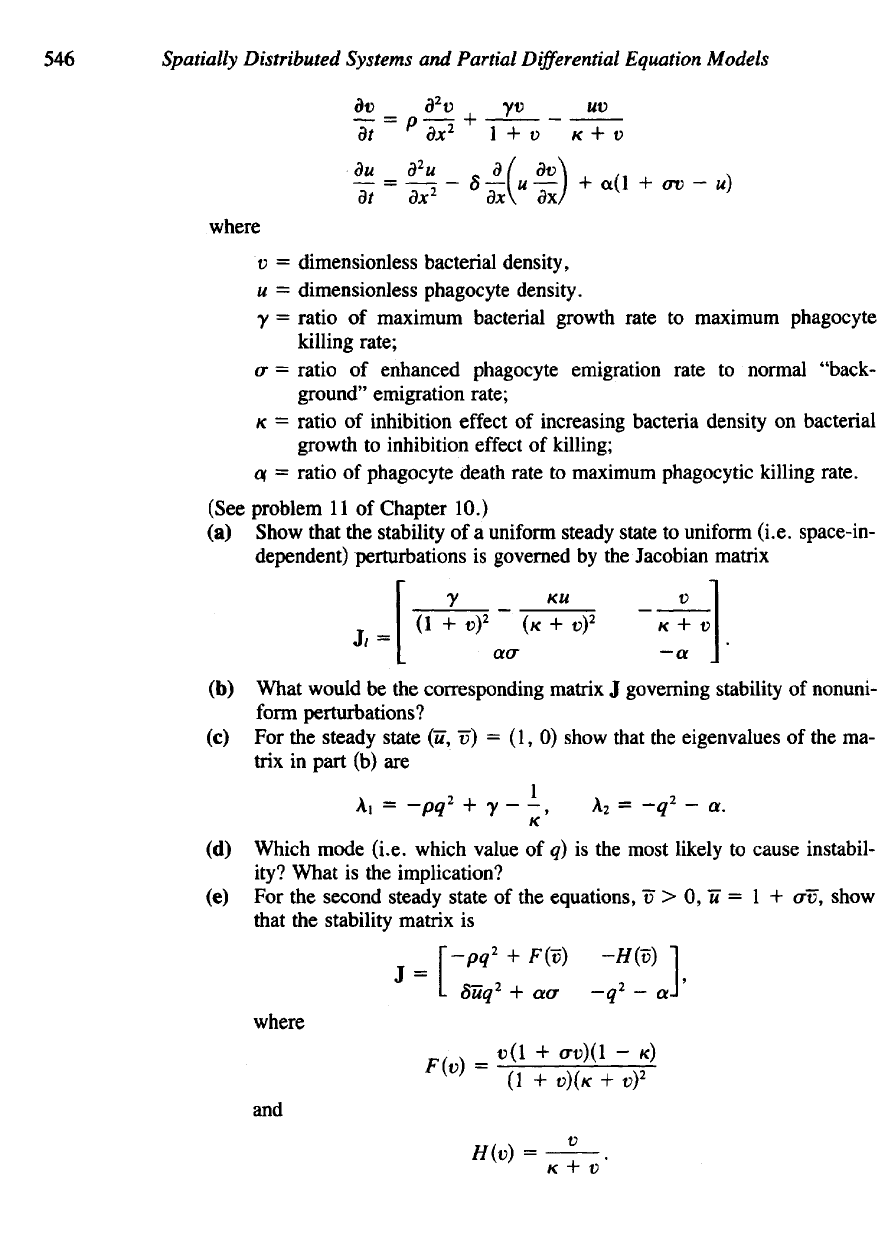
546
Spatially
Distributed Systems
and
Partial
Differential
Equation
Models
where
v =
dimensionless bacterial density,
u
=
dimensionless phagocyte density.
y =
ratio
of
maximum bacterial growth rate
to
maximum phagocyte
killing
rate;
cr
=
ratio
of
enhanced phagocyte emigration rate
to
normal
"back-
ground"
emigration rate;
K
=
ratio
of
inhibition
effect
of
increasing bacteria density
on
bacterial
growth
to
inhibition
effect
of
killing;
q =
ratio
of
phagocyte death rate
to
maximum
phagocytic killing rate.
(See problem
11 of
Chapter 10.)
(a)
Show that
the
stability
of a
uniform
steady state
to
uniform
(i.e. space-in-
dependent) perturbations
is
governed
by the
Jacobian matrix
(b)
What would
be the
corresponding matrix
J
governing stability
of
nonuni-
form
perturbations?
(c) For the
steady
state
(«",
TJ) = (1, 0)
show
that
the
eigenvalues
of the ma-
trix
in
part
(b) are
(d)
Which mode (i.e. which value
of q) is the
most likely
to
cause instabil-
ity?
What
is the
implication?
(e) For the
second
steady state
of the
equations,
t? > 0, H = 1 +
crv, show
that
the
stability matrix
is
where
and

Models
for
Development
and
Pattern Formation
in
Biological
Systems
547
and
that eigenvalues have negative real parts provided
the
following
in-
equalities
are
satisfied:
*(f)
Further discuss
how
diffusive
instability
might arise
in
this model.
You
may
wish
to
refer
to the
analysis
in
Lauffenburger
and
Kennedy (1983).
8.
Cells
in the
sluglike phase
of
Dictyostelium
discoideum
are
either prespore
or
prestalk,
and the two
cell classes maintain
a
definite
ratio despite experimental
manipulations such
as
excision
of
part
of the
mass.
Use a
simple model out-
lined
in
Chapter
7 to
suggest
one
type
of
mechanism that might lead
to
this
ra-
tio
regulation. Comment
on
ways
of
testing such
a
model.
9.
Reaction-diffusion
systems
(a) Use
Taylor-series expansions
for R\ and R
2
to
show that equations
(20a,b)
lead
to
equations (24a,b)
for
small perturbations.
(b)
Show that equations (24a,b)
are
equivalent
to
system
(26a-d).
(c)
Show that
by
assuming perturbations
of the
form
(27)
one
arrives
at
equations (28a,b).
(d)
Verify
that equation (30) results.
(e) Use the
inequality (33b) directly
to
reason that
diffusion
has the
capacity
to act as a
destabilizing
influence
[Hint:
note
the
effect
of
D
f
q
2
on the
self-influencing
terms a«.]
10. (a)
Show that
the
expression
on the LHS of
inequality (33b) corresponds
to
the
quantity defined
in
equation (35).
(b)
Demonstrate that H(q
2
)
has a
minimum,
and
prove that
q2min
is
given
by
(36a)
(Hint:
Set
dH/dq
2
- 0 and
solve
for
q
2
^.)
(c)
Evaluate
H(ql^.
(d)
Show that (34) implies (37).
(e)
Derive
inequality (38)
from
(37)
and
(32b).
(f)
Verify
that (38)
can be
written
in the
dimensionless
form
given
in
(39).
11. (a)
Justify
inequalities
(40)
and
(41).
(b)
Verify
inequality (45). What
are the
dimensions
of r\ and T
2
? of
D
2
/T
2
andDi/Ti?
(c)
Explain what
is
meant physically
by the
statement that
the
range
of
inhi-
bition should
be
larger than
the
range
of
activation.
(d)
Show that
for
(45)
to
hold
it
must
also
be
true that
D^ > D\.
(e)
Explain
the
deduction that spacing between patterns will
be
approxi-
mately
given
by
(46)
at the
onset
of
diffusive
instability.
(f)
Suggest what sort
of
biological
influences might bring about
the
parame-
ter
variation that leads
to
diffusive
instability.
*12.
The
growth
rate
of a
given wavenumber
q
t
is a/, and is
given
by
(30).
Describe
how one
could
use
this equation
to
solve
for
cr
it
and find the
wavenumber
of
the
fastest -growing perturbation.
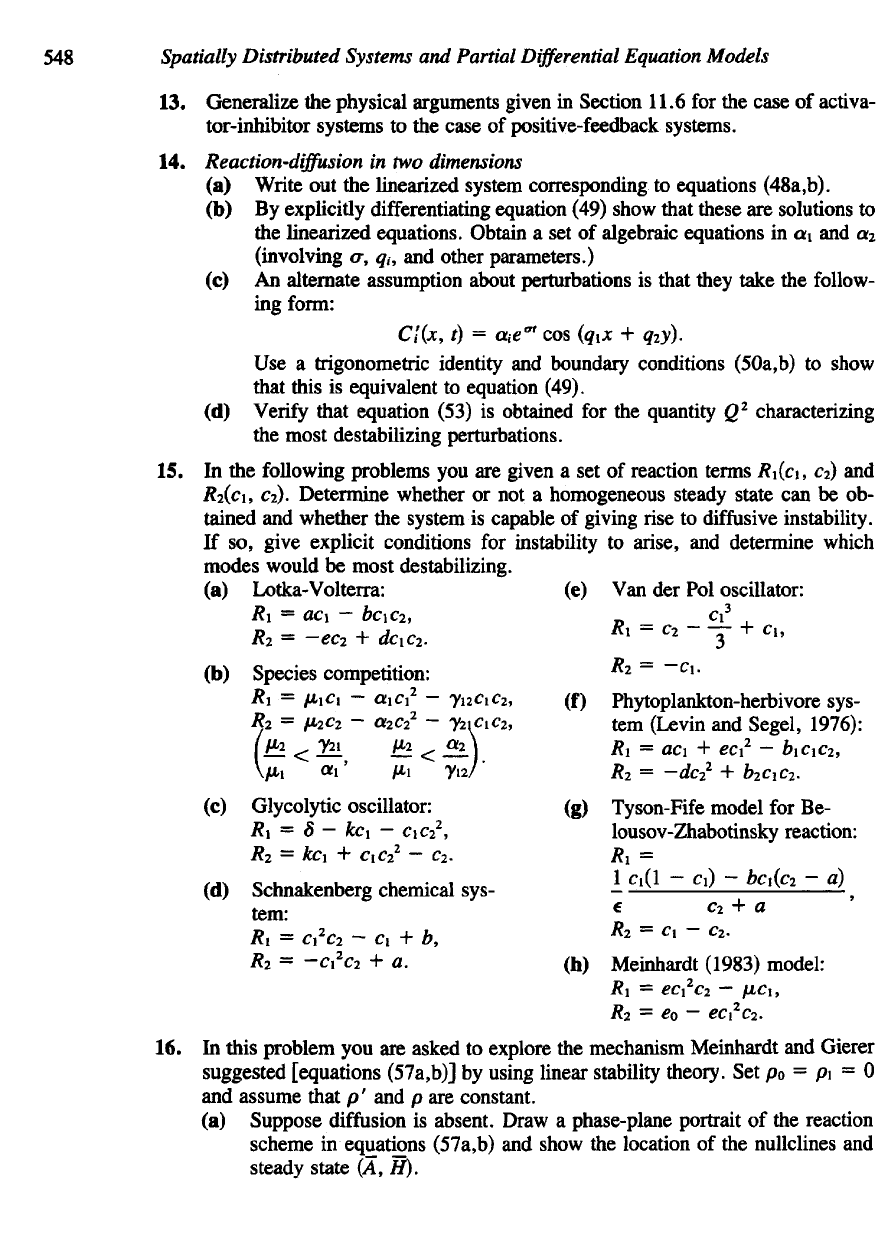
548
Spatially
Distributed
Systems
and
Partial
Differential
Equation
Models
In
this problem
you are
asked
to
explore
the
mechanism Meinhardt
and
Gierer
suggested [equations
(57a,b)]
by
using linear stability theory.
Set p
0
= pi = 0
and
assume that
p' and p are
constant,
(a)
Suppose
diffusion
is
absent. Draw
a
phase-plane portrait
of the
reaction
scheme
in
equations (57a,b)
and
show
the
location
of the
nullclines
and
steady
state
(A, H).
13.
Generalize
the
physical arguments given
in
Section 11.6
for the
case
of
activa-
tor-inhibitor
systems
to the
case
of
positive-feedback systems.
14.
Reaction-diffusion
in two
dimensions
(a)
Write
out the
linearized system corresponding
to
equations (48a,b).
(b) By
explicitly differentiating equation (49) show that these
are
solutions
to
the
linearized equations. Obtain
a set of
algebraic equations
in a\ and a^
(involving
cr, q
t
, and
other parameters.)
(c) An
alternate assumption about perturbations
is
that they take
the
follow-
ing
form:
Use a
trigonometric identity
and
boundary conditions
(50a,b)
to
show
that
this
is
equivalent
to
equation (49).
(d)
Verify
that equation (53)
is
obtained
for the
quantity
Q
2
characterizing
the
most destabilizing perturbations.
15. In the
following problems
you are
given
a set of
reaction terms
R\(CI,
c
2
) and
RZ(CI,
02). Determine whether
or not a
homogeneous steady state
can be ob-
tained
and
whether
the
system
is
capable
of
giving
rise to
diffusive
instability.
If
so,
give explicit conditions
for
instability
to
arise,
and
determine which
modes would
be
most destabilizing.
(a)
Lotka-Volterra:
(e) Van der Pol
oscillator:
(b)
Species competition:
(c)
Glycolytic oscillator:
(d)
Schnakenberg chemical sys-
tem:
(h)
Meinhardt (1983) model:
(g)
Tyson-rite
model
tor be-
lousov-Zhabotinsky reaction:
(f)
Phytoplankton-herbivore sys-
tem
(Levin
and
Segel, 1976):
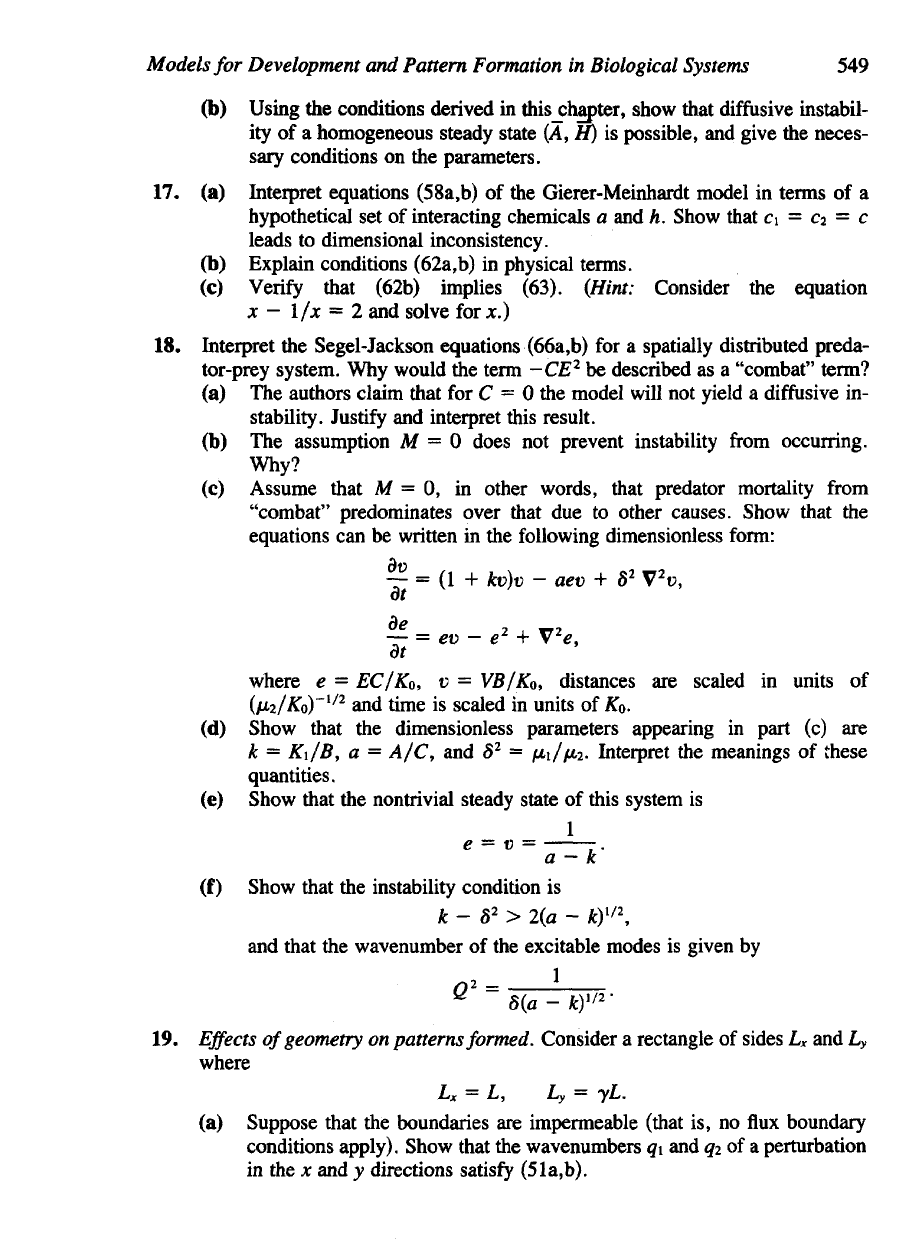
Models
for
Development
and
Pattern Formation
in
Biological
Systems
549
(b)
Using
the
conditions derived
in
thisjjhapter, show that
diffusive
instabil-
ity
of a
homogeneous steady state
(A, H) is
possible,
and
give
the
neces-
sary conditions
on the
parameters.
17. (a)
Interpret equations (58a,b)
of the
Gierer-Meinhardt model
in
terms
of a
hypothetical
set of
interacting chemicals
a and h.
Show that
c\ = c
2
= c
leads
to
dimensional inconsistency.
(b)
Explain
conditions
(62a,b)
in
physical terms.
(c)
Verify
that (62b) implies (63).
(Hint:
Consider
the
equation
x — l/x = 2 and
solve
for x.)
18.
Interpret
the
Segel-Jackson equations (66a,b)
for a
spatially distributed preda-
tor-prey system.
Why
would
the
term
—CE
2
be
described
as a
"combat"
term?
(a) The
authors claim that
for C = 0 the
model will
not
yield
a
diffusive
in-
stability.
Justify
and
interpret this result.
(b) The
assumption
M = 0
does
not
prevent instability
from
occurring.
Why?
(c)
Assume that
M = 0, in
other words, that predator mortality
from
"combat"
predominates over that
due to
other
causes.
Show
mat the
equations
can be
written
in the
following dimensionless
form:
where
e =
EC/K
0
,
v =
VB/K
0t
distances
are
scaled
in
units
of
(jji2/Ko)~
l/2
and
time
is
scaled
in
units
of
KQ.
(d)
Show that
the
dimensionless parameters appearing
in
part
(c) are
k
=
K\/B,
a =
A/C,
and 8
2
=
1*1/1*2.
Interpret
the
meanings
of
these
quantities.
(e)
Show that
the
nontrivial steady state
of
this system
is
(f)
Show that
the
instability condition
is
and
that
the
wavenumber
of the
excitable modes
is
given
by
19.
Effects
of
geometry
on
patterns formed. Consider
a
rectangle
of
sides
L
x
and L
y
where
(a)
Suppose that
the
boundaries
are
impermeable (that
is, no flux
boundary
conditions apply). Show that
the
wavenumbers
q\ and q
2
of a
perturbation
in
the x and y
directions
satisfy (51a,b).
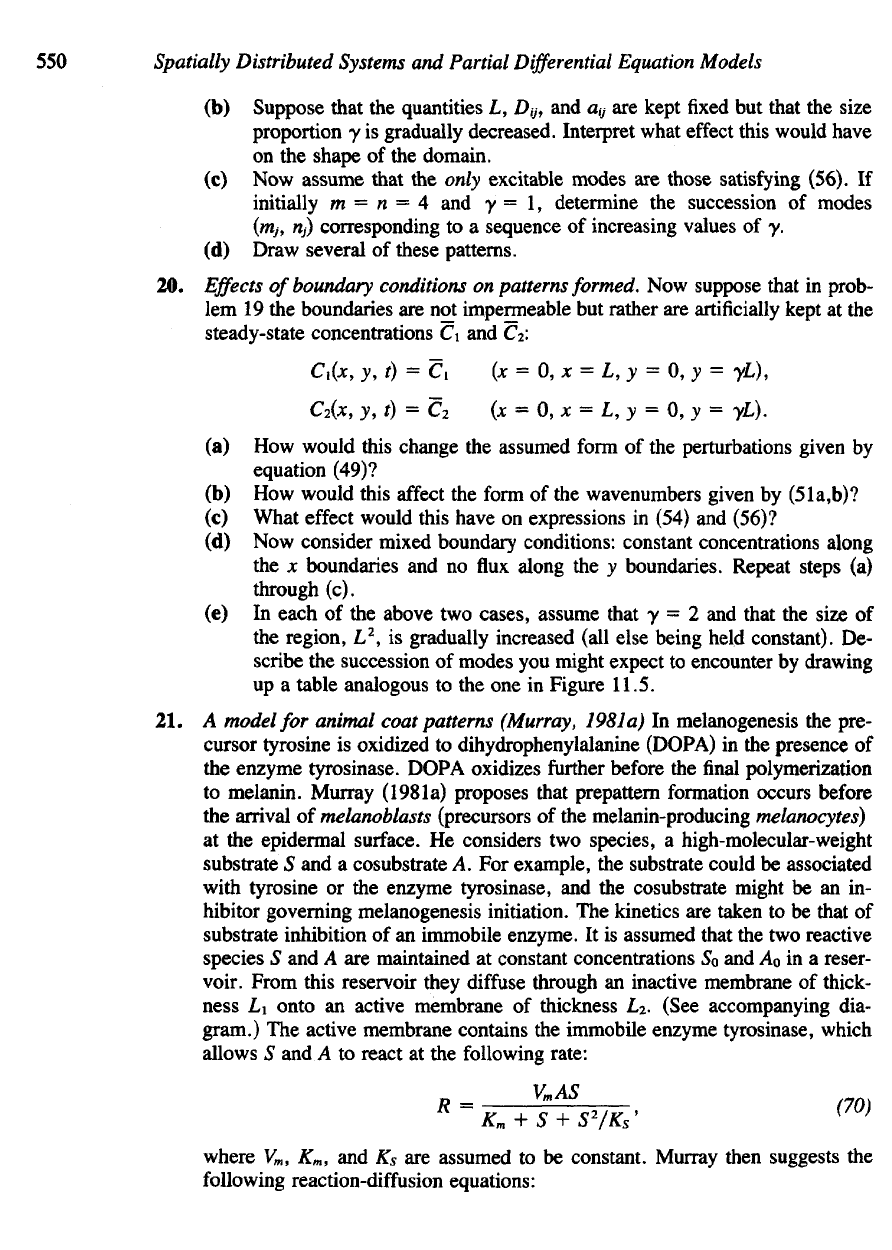
550
Spatially
Distributed
Systems
and
Partial
Differential
Equation
Models
(b)
Suppose that
the
quantities
L,
D,
7
,
and a
v
are
kept
fixed but
that
the
size
proportion
y is
gradually
decreased.
Interpret what
effect
this would have
on
the
shape
of the
domain.
(c) Now
assume
that
the
only
excitable
modes
are
those
satisfying (56).
If
initially
m = n = 4 and y = 1,
determine
the
succession
of
modes
(nij,
nj)
corresponding
to a
sequence
of
increasing values
of y.
(d)
Draw
several
of
these patterns.
20.
Effects
of
boundary
conditions
on
patterns formed.
Now
suppose that
in
prob-
lem 19 the
boundaries
are not
impermeable
but
rather
are
artificially
kept
at the
steady-state concentrations
C\ and d.
(a) How
would this change
the
assumed
form
of the
perturbations given
by
equation (49)?
(b) How
would this
affect
the
form
of the
wavenumbers given
by
(51a,b)?
(c)
What
effect
would this have
on
expressions
in
(54)
and
(56)?
(d) Now
consider
mixed boundary conditions: constant concentrations along
the
x
boundaries
and no flux
along
the y
boundaries. Repeat steps
(a)
through
(c).
(e) In
each
of the
above
two
cases,
assume that
y = 2 and
that
the
size
of
the
region,
L
2
, is
gradually increased (all else being held constant).
De-
scribe
the
succession
of
modes
you
might expect
to
encounter
by
drawing
up
a
table analogous
to the one in
Figure 11.5.
21. A
model
for
animal coat patterns
(Murray,
198la)
In
melanogenesis
the
pre-
cursor tyrosine
is
oxidized
to
dihydrophenylalanine (DOPA)
in the
presence
of
the
enzyme tyrosinase. DOPA oxidizes
further
before
the final
polymerization
to
melanin. Murray (198la) proposes that prepattern formation occurs before
the
arrival
of
melanoblasts (precursors
of the
melanin-producing
melanocytes)
at the
epidermal surface.
He
considers
two
species,
a
high-molecular-weight
substrate
5 and a
cosubstrate
A. For
example,
the
substrate could
be
associated
with
tyrosine
or the
enzyme tyrosinase,
and the
cosubstrate might
be an in-
hibitor governing melanogenesis initiation.
The
kinetics
are
taken
to be
that
of
substrate inhibition
of an
immobile enzyme.
It is
assumed that
the two
reactive
species
S and A are
maintained
at
constant concentrations
So and Ao in a
reser-
voir.
From this
reservoir
they
diffuse
through
an
inactive membrane
of
thick-
ness
Li
onto
an
active membrane
of
thickness
L^.
(See accompanying dia-
gram.)
The
active membrane contains
the
immobile enzyme tyrosinase, which
allows
S and A to
react
at the
following rate:
where
V
m
, K
m
, and K
s
are
assumed
to be
constant. Murray then suggests
the
following
reaction-diffusion equations:
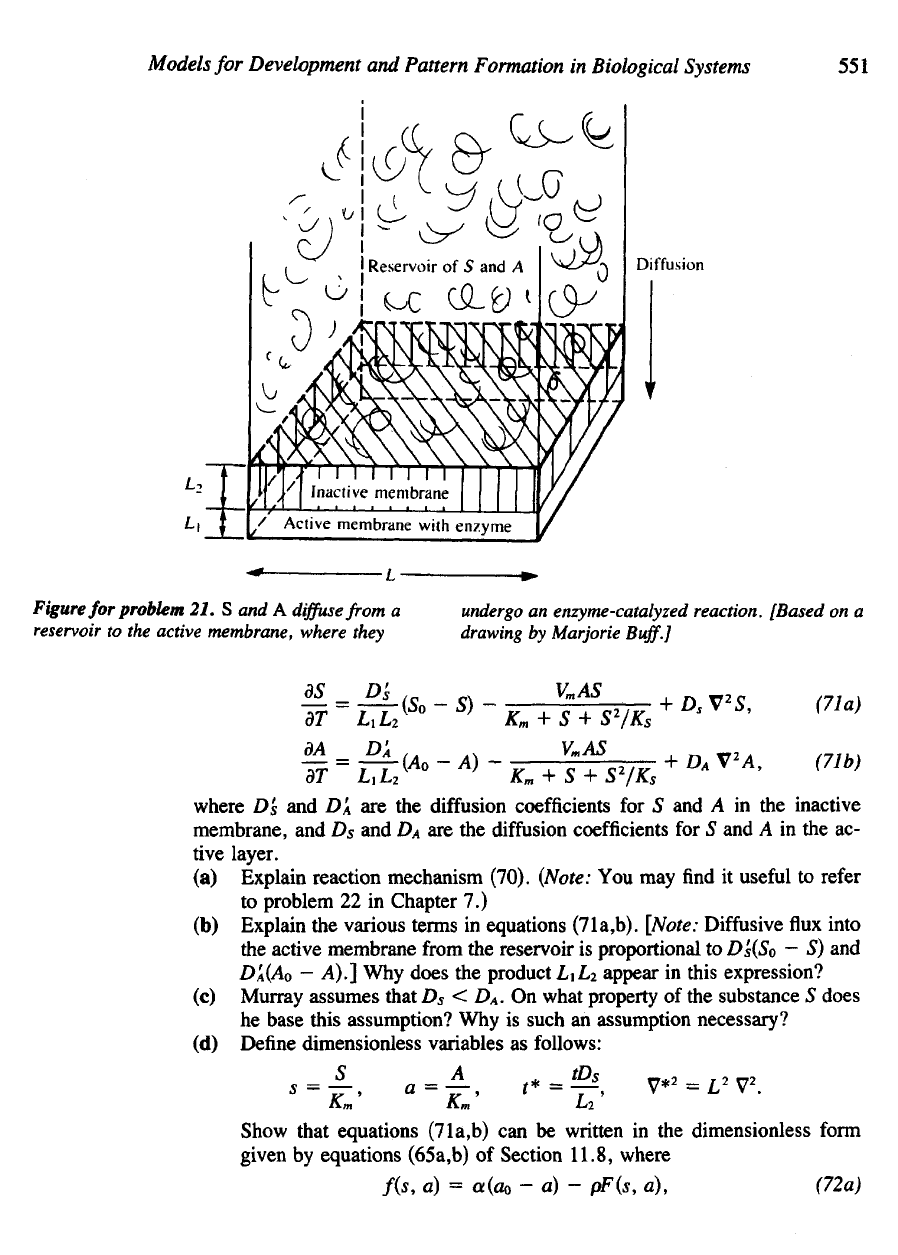
Models
for
Development
and
Pattern Formation
in
Biological
Systems
551
Figure
for
problem
21. S and A
diffuse
from a
reservoir
to the
active
membrane,
where
they
undergo
an
enzyme-catalyzed
reaction.
[Based
on a
drawing
by
Marjorie
Buff.]
where
DS and D'
A
are the
diffusion
coefficients
for S and A in the
inactive
membrane,
and D
s
and D
A
are the
diffusion
coefficients
for S and A in the ac-
tive layer.
(a)
Explain reaction mechanism (70).
(Note:
You may find it
useful
to
refer
to
problem
22 in
Chapter
7.)
(b)
Explain
the
various terms
in
equations (71a,b).
[Note:
Diffusive
flux
into
the
active
membrane
from
the
reservoir
is
proportional
to
D'
s
(So
— S) and
DA(A
O
—
A).]
Why
does
the
product LiL
2
appear
in
this expression?
(c)
Murray assumes that
D
s
< D
A
. On
what property
of the
substance
5
does
he
base this assumption?
Why is
such
an
assumption necessary?
(d)
Define dimensionless variables
as
follows:
Show
that equations (71a,b)
can be
written
in the
dimensionless
form
given
by
equations (65a,b)
of
Section 11.8, where
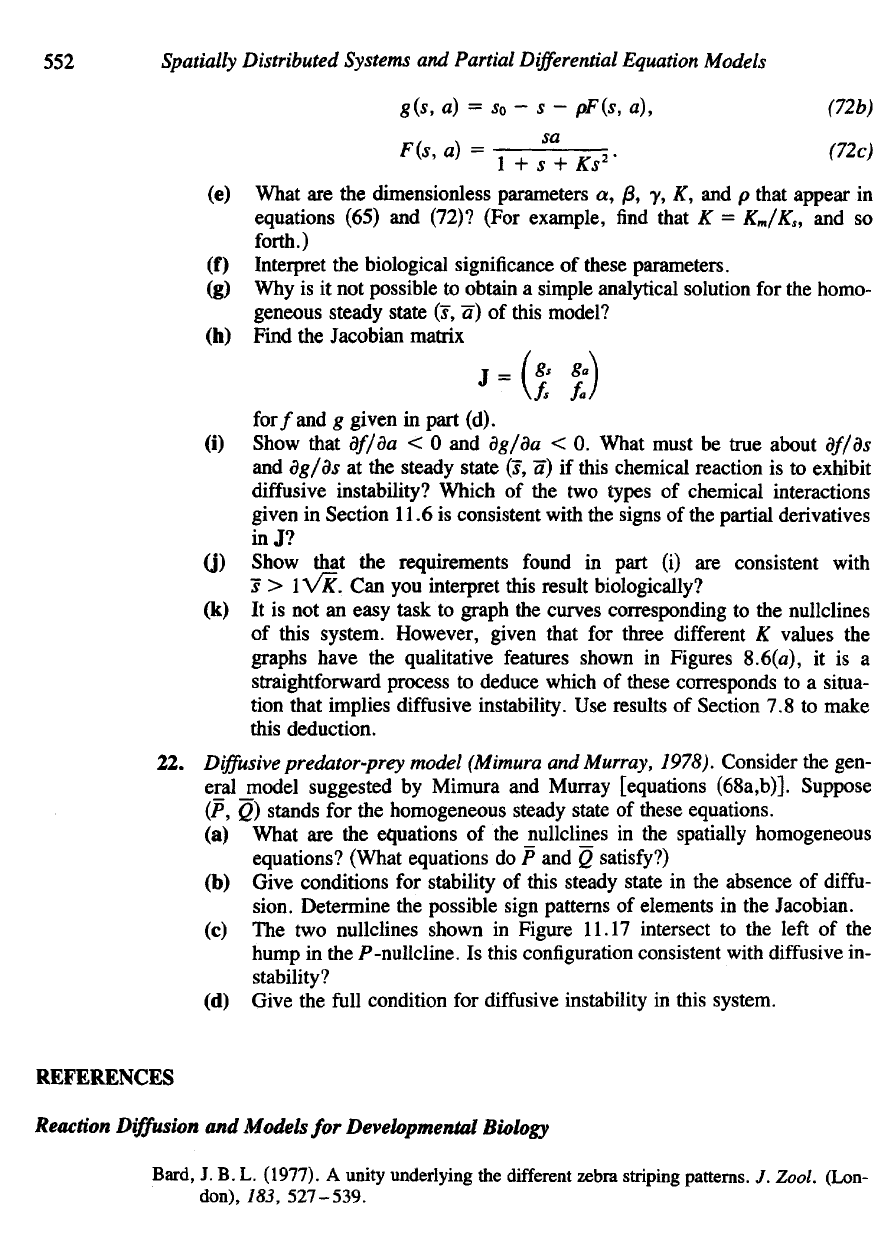
552
Spatially
Distributed
Systems
and
Partial
Differential
Equation
Models
(e)
What
are the
dimensionless parameters
a, /3, y, K, and p
that appear
in
equations
(65)
and
(72)? (For
example,
find
that
K =
K
m
/K
s
,
and so
forth.)
(f)
Interpret
the
biological
significance
of
these parameters.
(g) Why is it not
possible
to
obtain
a
simple analytical solution
for the
homo-
geneous steady state
(s,
"a)
of
this model?
(h)
Find
the
Jacobian matrix
for/and
g
given
in
part
(d).
(i)
Show that
df/da
< 0 and
dg/da
< 0.
What must
be
true about
df/ds
and
dg/ds
at the
steady
state
(J,
~a]
if
this chemical reaction
is to
exhibit
diffusive
instability? Which
of the two
types
of
chemical interactions
given
in
Section
11.6
is
consistent with
the
signs
of the
partial derivatives
inj?
(j)
Show that
the
requirements
found
in
part
(i) are
consistent with
J > 1
V/P.
Can you
interpret this result biologically?
(k) It is not an
easy task
to
graph
the
curves corresponding
to the
nullclines
of
this system. However, given that
for
three
different
K
values
the
graphs have
the
qualitative features shown
in
Figures
8.6(a),
it is a
straightforward
process
to
deduce which
of
these corresponds
to a
situa-
tion that implies
diffusive
instability.
Use
results
of
Section
7.8 to
make
this deduction.
22.
Diffusive
predator-prey model
(Mimura
and
Murray, 1978). Consider
the
gen-
eral
jnodel
suggested
by
Mimura
and
Murray [equations
(68a,b)].
Suppose
(P,
Q)
stands
for the
homogeneous steady state
of
these equations.
(a)
What
are the
equations
of the
jiullclines
in the
spatially homogeneous
equations? (What equations
do P and Q
satisfy?)
(b)
Give conditions
for
stability
of
this steady state
in the
absence
of
diffu-
sion. Determine
the
possible sign patterns
of
elements
in the
Jacobian.
(c) The two
nullclines shown
in
Figure
11.17
intersect
to the
left
of the
hump
in the
P-nullcline.
Is
this
configuration
consistent with
diffusive
in-
stability?
(d)
Give
the
full
condition
for
diffusive
instability
in
this system.
REFERENCES
Reaction
Diffusion
and
Models
for
Developmental
Biology
Bard,
J. B. L.
(1977).
A
unity
underlying
the
different
zebra
striping
patterns.
J.
Zool.
(Lon-
don),
183,
527-539.
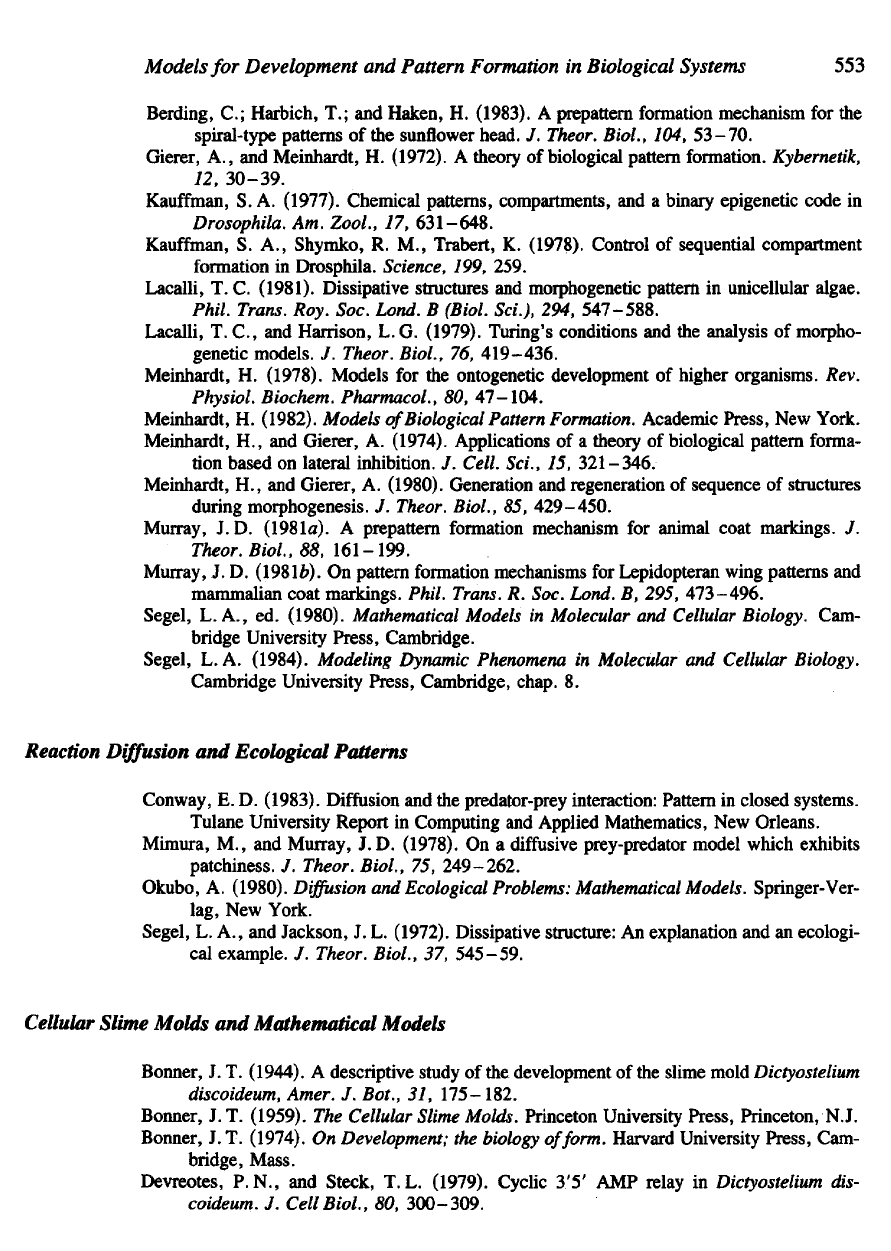
Models
for
Development
and
Pattern Formation
in
Biological
Systems
553
Berding,
C.;
Harbich,
T.; and
Haken,
H.
(1983).
A
prepattern formation mechanism
for the
spiral-type patterns
of the
sunflower head.
J.
Theor.
Biol.,
104,
53-70.
Gierer,
A., and
Meinhardt,
H.
(1972).
A
theory
of
biological
pattern formation.
Kybernetik,
12,
30-39.
Kauffman,
S. A.
(1977). Chemical patterns, compartments,
and a
binary epigenetic code
in
Drosophila.
Am.
Zool.,
17,
631-648.
Kauffman,
S. A.,
Shymko,
R. M.,
Trabert,
K.
(1978). Control
of
sequential compartment
formation
in
Drosphila. Science, 199, 259.
Lacalli,
T. C.
(1981). Dissipative structures
and
morphogenetic pattern
in
unicellular algae.
Phil. Trans. Roy. Soc. Lond.
B
(Biol.
Sci.), 294,
547–588.
Lacalli,
T. C., and
Harrison,
L. G.
(1979). Turing's conditions
and the
analysis
of
morpho-
genetic models.
/.
Theor.
Biol.,
76,
419-436.
Meinhardt,
H.
(1978). Models
for the
ontogenetic development
of
higher organisms. Rev.
Physiol. Biochem. Pharmacol.,
80,
47–104.
Meinhardt,
H.
(1982).
Models
of
Biological
Pattern Formation. Academic Press,
New
York.
Meinhardt,
H., and
Gierer,
A.
(1974). Applications
of a
theory
of
biological pattern
forma-
tion based
on
lateral inhibition.
/.
Cell. Sci.,
15,
321–346.
Meinhardt,
H., and
Gierer,
A.
(1980). Generation
and
regeneration
of
sequence
of
structures
during
morphogenesis.
J.
Theor.
Biol.,
85,
429–450.
Murray,
J. D.
(1981a).
A
prepattern formation mechanism
for
animal coat markings.
J.
Theor.
Biol.,
88,
161–199.
Murray,
J. D.
(1981fc).
On
pattern formation mechanisms
for
Lepidopteran wing patterns
and
mammalian coat markings. Phil. Trans.
R.
Soc. Lond.
B,
295,
473-496.
Segel,
L. A., ed.
(1980).
Mathematical
Models
in
Molecular
and
Cellular Biology. Cam-
bridge University Press, Cambridge.
Segel,
L. A.
(1984).
Modeling
Dynamic Phenomena
in
Molecular
and
Cellular Biology.
Cambridge University Press, Cambridge, chap.
8.
Reaction
Diffusion
and
Ecological Patterns
Conway,
E. D.
(1983). Diffusion
and the
predator-prey interaction: Pattern
in
closed systems.
Tulane University Report
in
Computing
and
Applied Mathematics,
New
Orleans.
Mimura,
M., and
Murray,
J. D.
(1978).
On a
diffusive
prey-predator model which exhibits
patchiness.
J.
Theor.
Biol.,
75,
249–262.
Okubo,
A.
(1980).
Diffusion
and
Ecological
Problems:
Mathematical
Models.
Springer-Ver-
lag,
New
York.
Segel,
L. A., and
Jackson,
J. L.
(1972). Dissipative structure:
An
explanation
and an
ecologi-
cal
example.
J.
Theor.
Biol.,
37,
545–59.
Cellular
Slime
Molds
and
Mathematical Models
Bonner,
J. T.
(1944).
A
descriptive study
of the
development
of the
slime mold
Dictyostelium
discoideum,
Amer.
J.
Bot.,
31,
175-182.
Bonner,
J. T.
(1959).
The
Cellular Slime Molds. Princeton University
Press,
Princeton, N.J.
Bonner,
J. T.
(1974).
On
Development;
the
biology
of
form. Harvard University Press, Cam-
bridge, Mass.
Devreotes, P.N.,
and
Steck,
T.L. (1979). Cyclic 3'5'
AMP
relay
in
Dictyostelium dis-
coideum.
J.
Cell
Biol.,
80,
300-309.
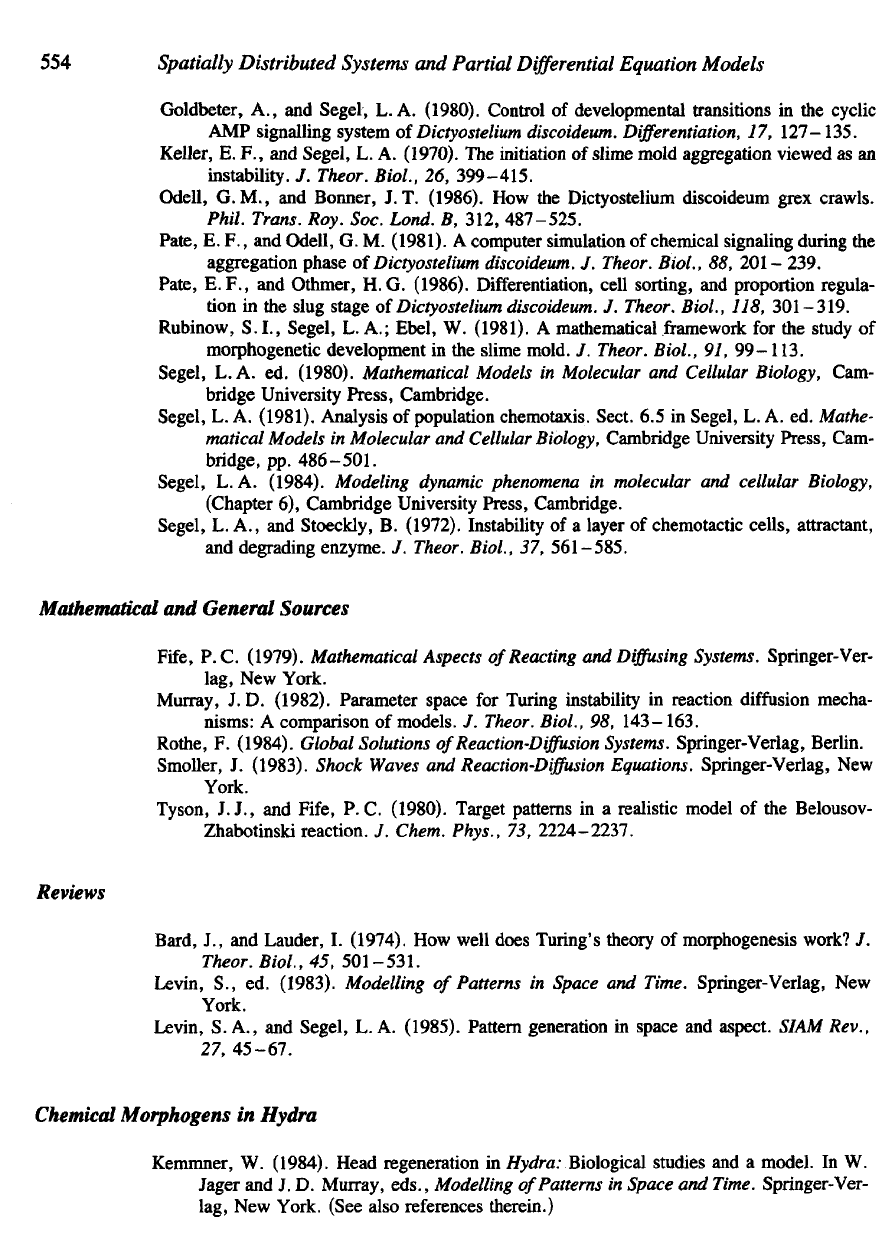
554
Spatially
Distributed
Systems
and
Partial
Differential
Equation
Models
Goldbeter,
A., and
Segel,
L. A.
(1980). Control
of
developmental transitions
in the
cyclic
AMP
signalling system
of
Dictyostelium
discoideum.
Differentiation,
17,
127-135.
Keller,
E. F., and
Segel,
L. A.
(1970).
The
initiation
of
slime mold aggregation viewed
as an
instability.
J.
Theor.
Biol.,
26,
399-415.
Odell,
G. M., and
Bonner,
J. T.
(1986).
How the
Dictyostelium discoideum grex crawls.
Phil. Trans. Roy. Soc. Lond.
B,
312,
487-525.
Pate,
E. F., and
Odell,
G. M.
(1981).
A
computer simulation
of
chemical signaling during
the
aggregation phase
of
Dictyostelium
discoideum.
J.
Theor.
Biol.,
88,
201–239.
Pate,
E. F., and
Othmer,
H. G.
(1986). Differentiation, cell sorting,
and
proportion regula-
tion
in the
slug stage
of
Dictyostelium
discoideum.
J.
Theor. Biol., 118,
301–319.
Rubinow,
S. I.,
Segel,
L. A.;
Ebel,
W.
(1981).
A
mathematical
framework
for the
study
of
morphogenetic development
in the
slime mold.
/.
Theor.
Biol.,
91,
99–113.
Segel,
L. A. ed.
(1980). Mathematical
Models
in
Molecular
and
Cellular Biology, Cam-
bridge University Press, Cambridge.
Segel,
L. A.
(1981). Analysis
of
population chemotaxis. Sect.
6.5 in
Segel,
L. A. ed.
Mathe-
matical
Models
in
Molecular
and
Cellular
Biology, Cambridge University Press, Cam-
bridge,
pp.
486-501.
Segel,
L. A.
(1984).
Modeling
dynamic
phenomena
in
molecular
and
cellular Biology,
(Chapter
6),
Cambridge University Press, Cambridge.
Segel,
L. A., and
Stoeckly,
B.
(1972). Instability
of a
layer
of
chemotactic
cells,
attractant,
and
degrading enzyme.
J.
Theor. Biol.,
37,
561–585.
Mathematical
and
General
Sources
Fife,
P. C.
(1979). Mathematical Aspects
of
Reacting
and
Diffusing
Systems. Springer-Ver-
lag,
New
York.
Murray,
J. D.
(1982). Parameter space
for
Turing instability
in
reaction
diffusion
mecha-
nisms:
A
comparison
of
models.
J.
Theor.
Biol.,
98,
143–163.
Rothe,
F.
(1984). Global Solutions
of
Reaction-Diffusion
Systems. Springer-Verlag, Berlin.
Smoller,
J.
(1983). Shock
Waves
and
Reaction-Diffusion
Equations. Springer-Verlag,
New
York.
Tyson,
J. J., and
Fife,
P. C.
(1980). Target patterns
in a
realistic model
of the
Belousov-
Zhabotinski reaction.
J.
Chem. Phys.,
73,
2224-2237.
Reviews
Bard,
J., and
Lauder,
I.
(1974).
How
well does Turing's theory
of
morphogenesis work?
J.
Theor.
Biol.,
45,
501-531.
Levin,
S., ed.
(1983).
Modelling
of
Patterns
in
Space
and
Time. Springer-Verlag,
New
York.
Levin,
S. A., and
Segel,
L. A.
(1985). Pattern generation
in
space
and
aspect.
SIAM
Rev.,
27,
45-67.
Chemical
Morphogens
in
Hydra
Kemmner,
W.
(1984). Head regeneration
in
Hydra:
Biological studies
and a
model.
In W.
Jager
and J. D.
Murray, eds.,
Modelling
of
Patterns
in
Space
and
Time. Springer-Ver-
lag,
New
York. (See also references therein.)

Models
for
Development
and
Pattern
Formation
in
Biological
Systems
555
Other
Pattern
Formation
Models
Ermentrout,
G. B.;
Campbell,
J.; and
Oster,
G.
(1986).
A
model
for
shell patterns based
on
neural activity.
Veliger,
28,
369-388.
Ermentrout,
G. B., and
Cowan,
J. D.
(1979).
A
mathematical theory
of
visual hallucination
patterns. Biol. Cybernet.,
34,
137-150.
Ermentrout,
G. B.
(1984). Mathematical models
for the
patterns
of
premigrainous auras,
in
A. V.
Holden
and W.
Winlow,
eds.,
The
Neurobiology
of
Pain, Manchester University
Press,
Manchester, England.
Cohen,
D.
(1967).
Computer simulation
of
biological
pattern generation
processes.
Nature,
216,
246-248.
Jackson,
J. B. C.;
Buss,
L. W.; and
Cook,
R. E., ed.
(1985). Population
Biology
and
Evolu-
tion
ofClonal
Organisms. Yale University Press,
New
Haven, Conn.
Murray,
J. D., and
Oster,
G. F.
(1984).
Cell
traction models
for
generating pattern
and
form
in
morphogenesis.
J.
Math.
Biol.,
19,
265-279.
Nijhout,
H. F.
(1981).
The
color patterns
of
butterflies
and
moths.
Sci. Am.,
November
1981,
pp.
140-151.
Odell,
G. M.;
Oster,
G.;
Alberch,
P.; and
Burnside,
B.
(1981).
The
mechanical
basis
of
mor-
phogenesis. Develop.
Biol.,
85,
446–462.
Oster,
G. F.;
Murray,
J. D.; and
Harris,
A. K.
(1983). Mechanical aspects
of
mesenchymal
morphogenesis.
J.
Embryol. Exp. Morph.,
78,
83–125.
Sulsky,
D.;
Childress,
S.; and
Percus,
J. K.
(1984).
A
model
of
cell sorting.
/.
Theor.
Biol.,
106,
275-301.
Swindale,
N. V.
(1980).
A
model
for the
formation
of
ocular dominance stripes. Proc.
R.
Soc. Lond.
B,
208,
243–264.
Thompson, D'Arcy,
W.
(1942).
On
Growth
and
Form. Cambridge University Press,
Cam-
bridge.
Young,
D. A.
(1984).
A
local activator-inhibitor model
of
vertebrate skin patterns. Math.
Biosci., 72,51–58.
Wolfram,
S.
(1984a). Cellular automata
as
models
of
complexity. Nature,
311,
419–424.
Wolfram,
S.
(1984&).
Universality
and
complexity
in
cellular automata. Physica,
10D,
1-35.
Miscellaneous
Lauffenburger,
D. A., and
Kennedy,
C. R.
(1983). Localized bacterial infection
in a
dis-
tributed model
for
tissue inflammation.
J.
Math.
Biol.,
16, 141
–163.
Schaller,
H. C.
(1973). Isolation
and
characterization
of a low
molecular weight substance
ac-
tivating head
and bud
formation
in
hydra.
J.
Embryol. Exp. Morphol.,
29,
27–38.
Schaller,
H. C.
(1976). Action
of the
head activator
on the
determination
of
interstitial cells
in
hydra. Cell.
Differ.
5,
13–20.
Nicolis,
G., and
Prigogine,
I.
(1977).
Self-Organization
in
Nonequilibrium Systems. Wiley,
New
York.
